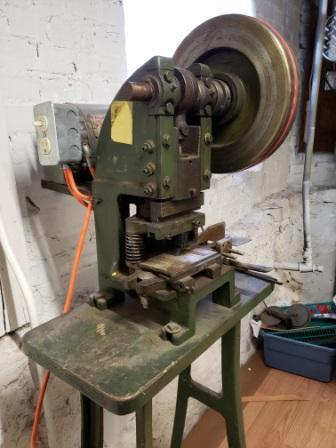-
Posts
6,523 -
Joined
-
Last visited
Content Type
Profiles
Forums
Events
Blogs
Gallery
Everything posted by Northmount
-
According to the IP address, gecko (Virgil Williams) is from the Saint Paul, Minnesota, 55104 area. Tom
-
@dtklunk Moved your post to leather Sewing Machines. You'll get more responses here. I see from your IP address that you are located in or near Hanover, Pennsylvania, 17331. It is a good idea to add your location to your profile so members can refer you to suppliers that are closer to you. Tom
-
Resize your photos to 800x600 pixels and you can post a hundred photos in a single post. Some helps are located here Got to the 2nd page and scroll down a few posts and you will find some current information and help. For some reason I can't link to the particular post, but you will be able to find one by me and another by wizcrafts Tom
-
@beyondcomfort Moved your post to Marketplace since you are selling. Please add additional information including shipping, pricing and pictures to your post as per marketplace requirements. See https://leatherworker.net/forum/forum/70-announcements/ Tom
-
@WinstonD Moved your post to Leather Sewing Machines. You will probably get more response here. Tom
-
For general information about power mallets, posts found on leatherworker.net see https://www.google.com/search?q=power+mallet+site%3Aleatherworker.net&ie=utf-8&oe=utf-8 Tom Edit: There is a Facebook page for support. I see people have been selling or asking to buy. "Power Mallet Leather Carvers"
-
The PDF of the catalog is 69 MB. So a little on the large side to email or post. Tempting to post it here but Tandy may not approve! If Jeff from Tandy wants to provide their approvals, I can post it here. Tom
-
.thumb.jpg.6e903dd66163ad5672f00f144058c571.jpg)
Oval Eyelet Changing Leather Color
Northmount replied to LeatherCritic's topic in Hardware and Accessories
Iron reacts with tannin in the vegtan leather to produce blue/black stains. Check out vinegaroon for more information on how the stain occurs. The stain can be removed by cleaning with oxalic acid. Have to keep vegtan and iron separated and dry to prevent it. Tom -
I'd go back to the seller for support. Talk to @Techsew Ron Tom
-
-
@Mark59 moved your post to leather sewing machines. You'll get more responses here. Tom
-
.thumb.jpg.6e903dd66163ad5672f00f144058c571.jpg)
Looking for first Heavy Duty Machine
Northmount replied to kbarker's topic in Leather Sewing Machines
@kbarker Moved your post to leather sewing machines. Tom -
Some pictures may help us be able to see and visualize what is happening. Tom
-
@ValkyrieEquine Moved your post to leather sewing machines. You'll get more participation from this group. Tom
-
@Secondgunman moved your post to leather sewing machines. You'll get more participation here when ddiscussing sewing machines. Review the following post about sizing photos to post on this site. https://leatherworker.net/forum/topic/15122-how-to-post-pictures-on-lw/?do=findComment&comment=551171 Tom
-
.thumb.jpg.6e903dd66163ad5672f00f144058c571.jpg)
Needle is puncturing not cutting my hard leather
Northmount replied to Husky3's topic in Leather Sewing Machines
@Husky3 Moved your post to Leather Sewing Machines. You will get more input here. There are lots of posts on these forums about using leatherpoint needles and about blowout when using conical point needles. There are several suggestions to help improve the appearance. Tom -
Another fantastic piece of art! I love your work! Tom
-
.thumb.jpg.6e903dd66163ad5672f00f144058c571.jpg)
getting tired of hand stitching...
Northmount replied to Apexpredcustoms's topic in Leatherwork Conversation
Add it to your profile so everyone becomes aware. Else you get offers from the UK or elsewhere! I see from your IP address that you are at Lacombe. So Leighton's is relatively close to you. Tom -
I would suggest that people would like to know where in the world they would be buying from and of course have some idea of the related shipping costs and time in transit. Also nice to know what part of eBay your listing will likely turn up on. There is no intended slight to you or anyone else. Just makes good business sense to know where you are dealing. Tom
- 15 replies
-
- henley swivel knives
- jeremiah watt
- (and 10 more)
-
OP is located in Palma, Balearic Islands, 07010, Spain according to his IP address. Tom
- 15 replies
-
- henley swivel knives
- jeremiah watt
- (and 10 more)
-
Haven't cut myself yet with a draw gauge, but have with the wooden strap cutter. I was squeezing the bars that hold the blade together to fit thinner leather. The knife came up through the top bar and bit me! Now there is a piece of leather glued over the top and bottom bars as a warning and for protection in case I didn't learn the lesson the first time. For the draw gauge, grind the point off, grind it to a good radius. You won't be using that top 1/4" anyhow and helps prevent accidental cuts if left sit upright. I've heard of fellows cutting their wrist reaching for something on the other side of the knife. Mine has a special place in a drawer and sits upside down, point down. Tom
-
@Soap Moved your post to Leather Sewing Machines. Tom
-
@Dufresne Moved your post to Leather Sewing Machines Tom
-
.thumb.jpg.6e903dd66163ad5672f00f144058c571.jpg)
Pressure foot issues with Cowboy 3200
Northmount replied to TheHollerLW's topic in Leather Sewing Machines
My guess is not the foot itself, but the balance between the inner and outer feet. I doubt that the foot is too long. There are others here more expert than I am. Tom



